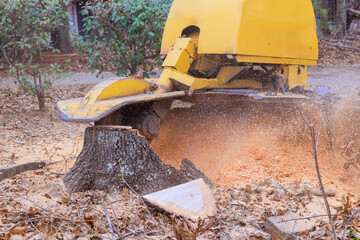Tree removal often leaves behind an unwanted reminder—the stubborn stump. While it may seem harmless at first, leaving a stump in your yard can cause more issues than you might expect. Stumps can attract pests, become a tripping hazard, and make your lawn look uneven and unattractive. That’s where stump grinding comes in. This efficient and cost-effective solution not only restores your outdoor space but also prevents long-term problems.

What Is Stump Grinding
Stump grinding is the process of removing a tree stump by using a specialized machine that grinds it down into small wood chips. Unlike complete stump removal, which involves pulling the entire stump and roots out of the ground, grinding focuses on eliminating the visible portion of the stump while leaving the roots to decay naturally underground.
The result is a smooth, level surface that can be replanted with grass, flowers, or new landscaping features. Because stump grinding does not require digging out large root systems, it is often less disruptive and more affordable than full stump removal.
Why You Should Not Ignore a Tree Stump
At first glance, a leftover stump may not seem like a big deal. However, over time, it can create several challenges that affect both safety and property value.
Safety Hazards
Tree stumps are notorious tripping hazards, especially in yards where children play or guests walk. They can also damage lawn equipment, such as mowers, if accidentally hit.
Pest Infestation
Old stumps are the perfect breeding ground for pests such as termites, ants, and beetles. Once these pests establish themselves in the stump, they can easily spread to nearby trees, plants, or even homes.
Yard Appearance
A smooth and well-kept yard can quickly lose its appeal with a large stump in the middle. Stumps create an uneven look that reduces curb appeal and makes landscaping less attractive.
Regrowth Issues
In some cases, stumps can sprout new shoots. These sprouts can drain nutrients from surrounding plants and create unwanted brush growth that requires constant trimming.
Benefits of Stump Grinding
Choosing stump grinding offers several important benefits for homeowners and property managers.
Restores Lawn Appearance
Grinding eliminates the unsightly remains of a tree, giving your yard a cleaner and more polished look. The wood chips created during the process can even be repurposed as mulch for flower beds or walkways.
Prevents Accidents
Once the stump is ground down, the risk of trips and falls disappears. This makes your yard safer for children, pets, and visitors.
Protects Against Pests
By removing the decaying wood that attracts insects, stump grinding helps protect your yard and home from infestations.
Improves Landscaping Options
Without a stump in the way, you can plant grass, shrubs, or even another tree in the same area. Stump grinding gives you the freedom to redesign your outdoor space without limitations.
Quick and Efficient
Compared to full stump removal, grinding is faster and less invasive. The machine grinds the stump below ground level, leaving the area ready for immediate replanting or landscaping.
The Stump Grinding Process
Understanding how stump grinding works can help you appreciate why it is the preferred method of dealing with tree stumps.
- Assessment – The size, location, and condition of the stump are evaluated to determine the right approach.
- Preparation – The area around the stump is cleared of rocks and debris to allow safe access for the grinder.
- Grinding – A stump grinder, equipped with a rotating blade, chips away at the stump until it is reduced to small wood particles.
- Backfilling – The hole left after grinding is filled with wood chips and soil, creating a level surface.
- Cleanup – Excess debris is removed, and the area is left ready for new landscaping.
Factors That Affect Stump Grinding
The cost and time required for stump grinding often depend on several factors:
- Stump Size – Larger stumps take more time and effort to grind than smaller ones.
- Wood Hardness – Dense hardwood stumps are tougher to grind compared to softwood stumps.
- Location – Stumps located near buildings, fences, or other obstacles may require more careful grinding.
- Root System – Some stumps have extensive root networks that may require deeper grinding for complete removal.
Stump Grinding vs Stump Removal
While both methods eliminate stumps, they differ in approach and results.
- Stump Grinding – Quick, efficient, and less invasive. The roots remain underground and naturally decompose over time. Best for most residential yards.
- Stump Removal – Involves pulling out the stump along with its roots. More disruptive, but necessary if you plan to build or install structures in the same spot.
For most homeowners, stump grinding offers the perfect balance of efficiency and effectiveness without causing unnecessary damage to the landscape.
Eco-Friendly Aspects of Stump Grinding
Stump grinding is also an environmentally friendly option. Instead of leaving a decaying stump to release carbon and attract pests, the wood chips created can be reused as mulch. This not only reduces waste but also supports healthier soil and plants in your garden.
Additionally, allowing the underground roots to naturally decompose enriches the soil over time, promoting new growth in the area.
Stump grinding is one of the most effective and convenient ways to restore your yard after tree removal. It enhances curb appeal, improves safety, prevents pest problems, and opens up new possibilities for landscaping. Whether you want to plant fresh grass, add a garden bed, or simply enjoy a smoother lawn, grinding away unwanted stumps is a smart investment in your property.
By choosing this efficient solution, you not only protect your yard but also create a cleaner, safer, and more attractive outdoor space for years to come.